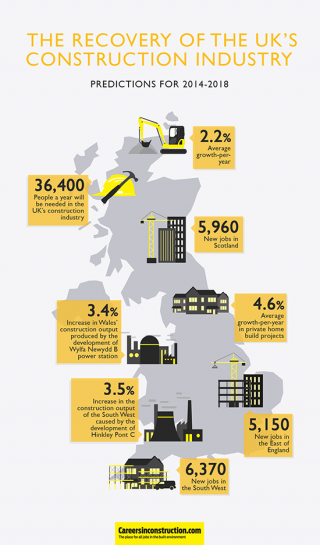Growth of Construction Industry in the UK

The Construction Industry Training Board (CITB) reported in January that the growth of the UK's construction industry would lead to a vast increase in jobs in 2014 - and beyond. The areas of growth, outlined by the report, vary across the UK - by geographical location and by the type of construction involved.
The road to recovery
The construction industry was one of the UK's business sectors hit hardest by the international financial turmoil of 2007. By the end of 2013, construction output had fallen by 15% - compared to its 2007 peak. The level of construction industry employment had also shrunk, in those five years, by 13%.
The annual Construction Skills Network (CSN) report, released by the CITB, marks a change in that trend, highlighting that, between 2014 and 2018, over 182,000 extra jobs will need to be filled in the construction industry to meet labour demands. The report even goes as far as to raise the prospect of a looming skills shortage, should the construction industry not receive the influx of workers it needs. According to the CITB report, the UK's construction industry will need to recruit 36,400 people a year to keep up with the growing levels of demand.
Unexpected growth
The sharp increase in growth is in stark contrast to the 2013 CSN report, which predicted a fall in the number of construction jobs until 2016. With levels of construction output having fallen by 8% in 2012, and only 1% in 2013, CITB now predict an average growth-per-year of 2.2% - until 2018. The new figures, revealing a much higher than expected demand for employment, take into account increased workload levels and migration out of and within the construction industry, through retirement and other factors.
Boom areas: Housing and Nuclear
The single biggest contributor to the CITB's predictions for 2014 is the UK's housing construction market. The report claims that housing will make up more than one third of the UK's construction output in the period between 2014 and 2018, in projects spanning the public, private and new-build fields. The report singles out private home build projects as a significant boom area - with an average growth of 4.6% per year expected up to 2018.
Regional employment figures will also receive a boost from the construction of new nuclear power plants. In the south west, the Hinkley Pont C power station is scheduled for a mid-2014 start date - and, it is estimated, will create 6,370 new jobs annually. The project should boost the construction output of the region to 3.5% between 2014 and 2018 - compared to the 2.2% found elsewhere in the UK. In Wales, a proposed new build nuclear plant, the Wylfa Newydd B in Anglesey, holds the same potential for growth - if construction begins this year, Wales' construction output is predicted to increase 3.4% over a five year period.
Set to benefit most from the upturn in construction growth are Scotland, with a potential 5,960 new jobs, and the south-west, with 6,370 new jobs. The east of England will also receive a huge employment boost, with approximately 5,150 new employees needed to fill construction roles. In all areas of the country, house building trades, such as bricklaying, roofing, carpentry, plastering and general labouring are predicted to be significant employment areas, but speciality personnel, like civil engineers, will also be sought after.
Have a look at the jobs we have available here
